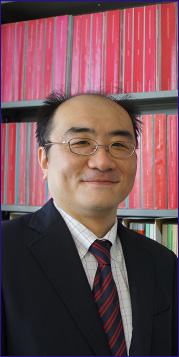

Necessity of Storing Electricity
Although electricity is a convenient energy source that can be used at any time by turning on switches, the difficulty of storing it is a major issue. In other words, electricity needs to be consumed immediately after it is generated. In Japan, electric power demand reaches a peak level during the midday in midsummer. Then we need enough electric power facilities, such as power plants and transmission lines, in order to supply electricity during peak demand. As a result of this fact, half of the facilities are almost unused throughout the year.At the same time, despite the progressive development of renewable energy such as solar energy and wind energy, these energy resources depend on sun and wind conditions, meaning that their power cannot be generated whenever it is required. For this reason, development of highly efficient storage technology is important from the perspectives of effective use of facilities and stable power supply.
Storage Technology that Applies Superconductivity
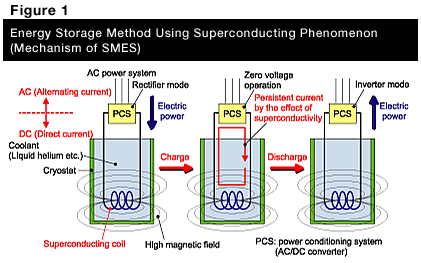
Charging is conducted by converting alternating current (AC) from a power network into direct current (DC), thereby exciting the superconducting coil. Conversely, when converting DC into AC, the stored energy is provided to a power network. By the effect of zero electrical resistance, energy storage is realized by circulating the persistent current through the circuit. In other words, electricity can be stored directly without energy conversion. This feature means that SMES is expected to be an ideal storage device. However, in order to store a large amount of energy, the superconducting coil should be excited up to a higher magnetic field with a large current. Due to this, induced electromagnetic forces are serious problems in large-scale SMES.
Ideal Superconducting Coil Configuration for Effective Energy Storage
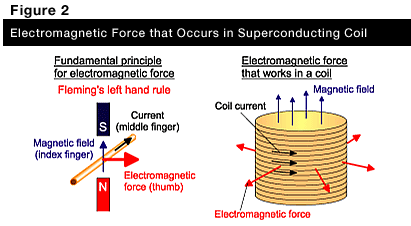
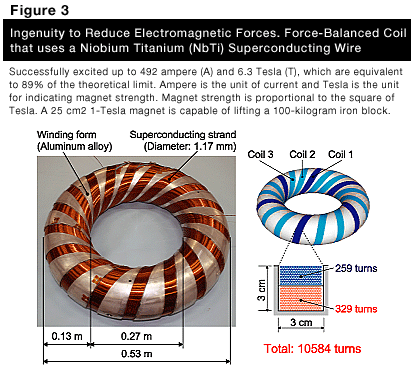
Although a conventional coil has a simple configuration using a cylindrical winding form, the induced electromagnetic forces will cause the coil radius (Figure 2) to expand. In order to support induced electromagnetic forces, a large coil especially requires a bedrock support. This fact involves a serious problem in constructing large-scale SMES. The scale of electromagnetic force reaches a maximum value when the magnetic field and the electric current vertically intersect. As a solution to this problem, a coil shown in Figure 3 called the Force-Balanced Coil, which is created by winding superconducting wire onto a donut-shaped winding form in spirals, enables excessive electromagnetic forces to be balanced. Such ingenuity is expected to open up the possibilities of realizing a large storage device.
The Force-Balanced Coil (Figure 3) is a coil that I developed in a previous institute to which I was assigned, in which students and I manually completed winding the coil with over 10,000 turns after four months. From the experimental results using liquid helium cooling, the coil was successfully excited to up to 89% of the theoretical limit. However, over 100 trial operations were required due to the complicated winding configuration. Future plans call for resolving technological issues of production technology and enhancing capability.
Future Image of Energy StorageDevice
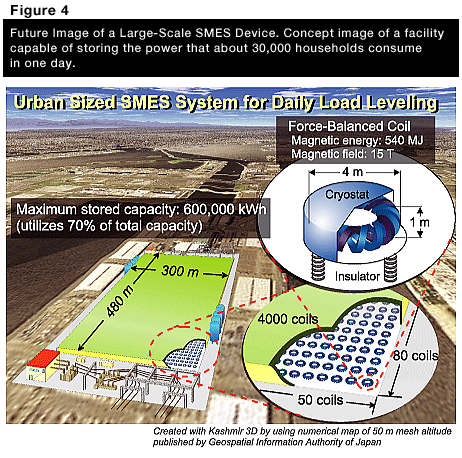
Japan’s World-Leading Superconducting Technology

Specifically, Japan’s superconducting technology is continuously advancing to lead the world. In 20 years, superconducting linear high-speed railroads (Superconducting Magnetically Levitated Vehicle (MAGLEV)) will become accessible, whereby superconductivity will become more intimately connected to our daily lives. Superconducting engineering is the world of experimental engineering that will remain “unknown unless actually implemented through trial and error.” In order to steadily hand down the know-how of superconducting technology, which is Japan’s strong suit, I consider my mission to be to nurture as many human resources as possible to be capable of taking the lead in the global vanguard and see them off into society. Additionally, going forward, I will strive to provide research and educational guidance with the aim of creating a base for students and researchers throughout the world to gather at Meiji University under the keyword of superconductivity.
Profile
Associate Professor Shinichi Nomura, Department of Electronics and Bioinformatics, School of Science and Technology, specializing in electrical power engineering and superconducting engineering.Born in Shizuoka Prefecture in 1973. Graduated from Department of Electrical Engineering in the School of Science and Technology, Meiji University in 1996. Completed a doctoral program in the Department of Energy Sciences, the Interdisciplinary Graduate School of Science and Engineering, Tokyo Institute of Technology in 2001. Conferred with a Doctor of Engineering degree by Tokyo Institute of Technology in 2001.
Worked as a lecturer (researcher of institute) at the Research Laboratory for Nuclear Reactors, Tokyo Institute of Technology from 2001 to 2002; a research fellow of the Japan Society for the Promotion of Science from 2002 to 2005; an industry-academia-government collaboration researcher at the Research Laboratory for Nuclear Reactors, Tokyo Institute of Technology in 2005; a solutions researcher at the Integrated Research Institute, Tokyo Institute of Technology from 2005 to 2008; and an assistant professor at the Integrated Research Institute, Tokyo Institute of Technology from 2008 to 2010. Has held current position since 2010.
Society Membership
IEEE (The Institute of Electrical and Electronics Engineers, Inc.), The Institute of Electrical Engineers of Japan, Cryogenics and Superconductivity Society of Japan, The Japan Society of Plasma Science and Nuclear Fusion Research (JSPF).Recent Academic Papers
1) S. Nomura, K. Tsuboi, K. Ito, H. Tsutsui, S. Tsuji-Iio, A. Ninomiya, and R. Shimada, “Acoustic Emission in a Superconducting Force-Balanced Helical Coil”, IEEE Trans. Applied Superconductivity, 21 (3), 1636-1639 (2011).2) S. Nomura, T. Shintomi, S. Akita, T. Nitta, R. Shimada, and S. Meguro, “Technical and Cost Evaluation on SMES for Electric Power Compensation”, IEEE Trans. Applied Superconductivity, 20 (3), 1373-1378 (2010).
Other Research Activity
A member of the technical committee of the Research Association of Superconducting Magnetic Energy Storage (RASMES) in Japan. As a research activity of RASMES, investigated the technical status of SMES, and developed a road map of SMES toward 2050 by request of the IEA (International Energy Agency).Visiting Researcher (Visiting Associate Professor) of the National Institute of Fusion Science from 2011.









